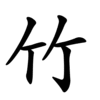竹
| ||||||||
| ||||||||
Translingual
| Stroke order | |||
|---|---|---|---|
 | |||
Han character
竹 (Kangxi radical 118, 竹+0, 6 strokes, cangjie input 竹 (H), four-corner 88220, composition ⿰亇亇)
- Kangxi radical #118, ⽵.
Derived characters
- Appendix:Chinese radical/竹
- 𪠿, 𬳕, 𢎉, 𫇸
References
- KangXi: page 877, character 1
- Dai Kanwa Jiten: character 25841
- Dae Jaweon: page 1305, character 4
- Hanyu Da Zidian (first edition): volume 5, page 2947, character 1
- Unihan data for U+7AF9
Chinese
| simp. and trad. |
竹 | |
|---|---|---|
Glyph origin
| Historical forms of the character 竹 | ||||||||||||||||||||||||||
|---|---|---|---|---|---|---|---|---|---|---|---|---|---|---|---|---|---|---|---|---|---|---|---|---|---|---|
| Shang | Western Zhou | Warring States | Shuowen Jiezi (compiled in Han) | Liushutong (compiled in Ming) | ||||||||||||||||||||||
| Bronze inscriptions | Oracle bone script | Bronze inscriptions | Bronze inscriptions | Chu slip and silk script | Qin slip script | Small seal script | Transcribed ancient scripts | |||||||||||||||||||
 |
 |
 |
 |
 |
 |
 |
 | |||||||||||||||||||
| ||||||||||||||||||||||||||
|
References: Mostly from Richard Sears' Chinese Etymology site (authorisation),
| ||||||||||||||||||||||||||
Pictogram (象形) – two bamboo stalks, with leaves. Earlier forms resembled 个 + 个, current form resembles rather ケ + ケ.
Etymology
Compare Proto-Tai *b.twuːkᴰ (“bamboo strip for tying or weaving”), whence Thai ตอก (dtɔ̀ɔk, “bamboo strip”).
Pronunciation
Definitions
竹
Synonyms
Compounds
|
|
|
Japanese
Readings
Compounds
- 真竹 (madake) timber bamboo (Phyllostachys bambusoides)
- 孟宗竹 (mōsōchiku) moso bamboo, Phyllostachys pubescens
- 淡竹 (hachiku) henon bamboo, a form of Phyllostachys nigra (black bamboo)
- 松竹梅 (shōchikubai): An arrangement of pines (松, matsu), bamboo (竹, take), and plum blossoms (梅, ume).
- 竹蜻蛉 (taketonbo): a bamboo dragonfly/bamboo-copter; a toy
- 緑竹 (ryokuchiku): lush green bamboo
- 竹簡 (chikukan)
- 竹馬 (takeuma)
- 竹林 (chikurin)
- 竹薮 (takayabu)
- 竹刀 (shinai)
- 糸竹 (shichiku)
Etymology
| Kanji in this term |
|---|
| 竹 |
| たけ Grade: 1 |
| kun’yomi |
From Old Japanese, from Proto-Japonic *takay.
Theories on derivation include:[1][2]
- From 長生 (takeou) or 高生 (takahae), in reference to the speed at which bamboo grows.
- Cognate with 高 (taka), 長 (take), 丈 (take) "height".
- From 高景 (takakake) or つらこえ (tsurakoe).
- From ta meaning "tall" (高い (takai)) + ke, ancient form of 木 (ki, “tree”).
- A contraction of 痛快茎延へ (itakukihae), referring to the speed at which bamboo grows.
- Ta is from Korean 대 (dae, “bamboo”) (see also 대나무 (daenamu, “bamboo”, literally “bamboo tree”)), while ke is an ancient form of 木 (ki).
Noun
竹 • (take)
- bamboo
- 『竹取物語』
- “Taketori Monogatari”
- The Tale of the Bamboo Cutter
- 『竹取物語』
- the middle of a 3-tier ranking system
References
- “タケ”, in 日本大百科全書:ニッポニカ (Nippon Dai Hyakka Zensho: Nipponica, “Encyclopedia Nipponica”) (in Japanese), Tōkyō: Shogakukan, 1984
- “竹”, in 日本国語大辞典 (Nihon Kokugo Daijiten, “Nihon Kokugo Daijiten”) (in Japanese), 2nd edition, Tōkyō: Shogakukan, 2000, →ISBN
- 2006, 大辞林 (Daijirin), Third Edition (in Japanese), Tōkyō: Sanseidō, →ISBN
- 1998, NHK日本語発音アクセント辞典 (NHK Japanese Pronunciation Accent Dictionary) (in Japanese), Tōkyō: NHK, →ISBN
Korean
Etymology
From Middle Chinese 竹 (MC ʈɨuk̚). Recorded as Middle Korean 듁〮 (tyúk) (Yale: tyuk) in Hunmong Jahoe (訓蒙字會 / 훈몽자회), 1527.
















